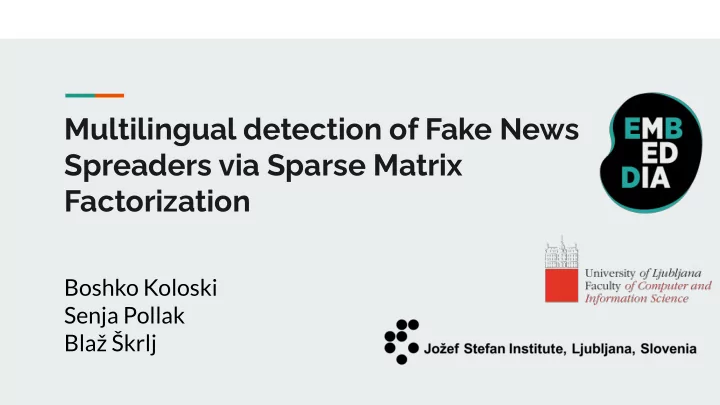

Multilingual detection of Fake News Spreaders via Sparse Matrix Factorization Boshko Koloski Senja Pollak Blaž Škrlj
Task Given Twitter feed of an author determine if the user is: - Fake-news spreader - Non-spreader Languages: English & Spanish ● 30 tweets per author, 150 negative & 150 positive cases for both languages ● Evaluation on classification accuracy ●
Motivation Fake news make a significant impact on society ● Analysis of representations' expressiveness learned via multilingual ● LSA
Preprocessing
Feature generation Example tweet: 1) Character n-grams (1,2) : - 1-gram: d, o, n ; 2-gram: do, on, nt ; 2) Word n-grams (2,3) : - 2-grams: dont know; 3-gram: dont know where; 3) TF-IDF on generated features
Latent Semantic Analysis
Visualization of training data
Models Stochastic Gradient Descent based: ● linear-SVM ○ logistic regression ○ Monolingual vs Multilingual model ● 10-fold GridSearchCV on 90% on the data; evaluate on 10% ●
Optimization Grid search on: ● Number of generated features, n : [2500, 5000, 10000, 20000, 30000] ○ Number of dimensions in the SVD, d : [128, 256, 512, 640, 768, 1024] ○ Model fine-tuning(regularization): ● ElasticNet regularization ○ Lasso ■ Ridge ■
Learning pipeline
Learning
Alternative approaches Separate model for each language ● Doc2Vec & BERT representations ● Different Tokenizer: TweetTokinzer ● Tested AutoML methods, scored similarly to the proposed model ●
Results on DEV
Final evaluation results
Conclusion Space obtained by word and character n-grams is a good representation of the ● problem space. Semantic features don’t introduce significant improvements. ● Multilingual space maintains space structure and word patterns. ● Multilingual approach tackles the problem better compared to the monolingual ● approach.
Further work Explore and exploit the multilingual approach on more languages. ● Try to enrich the space with a background knowledge about entities appearing ● in the text.
Recommend
More recommend